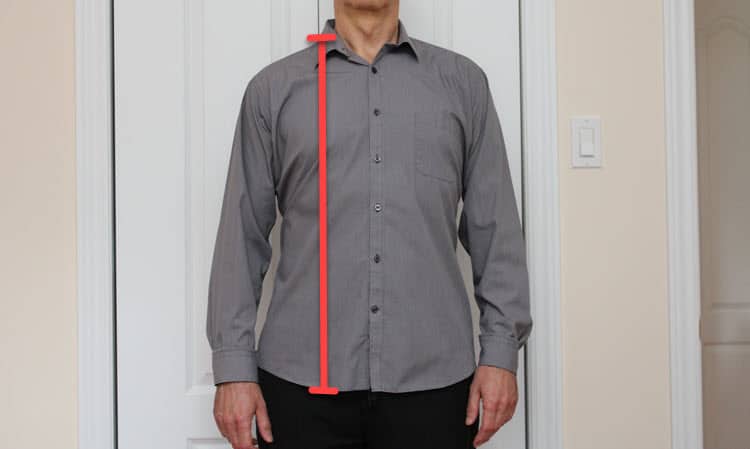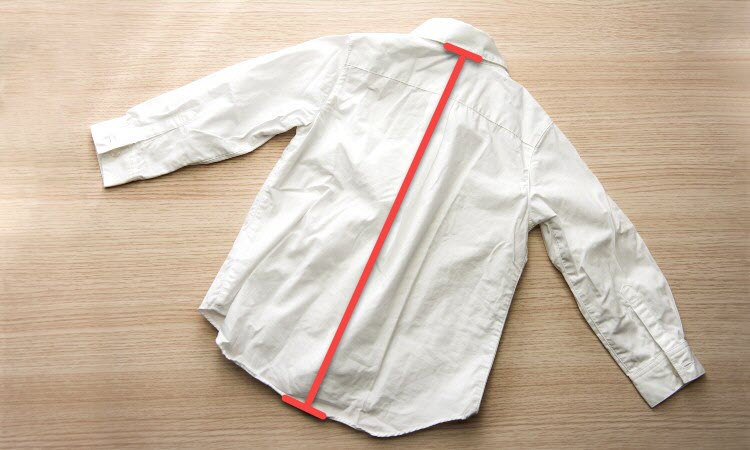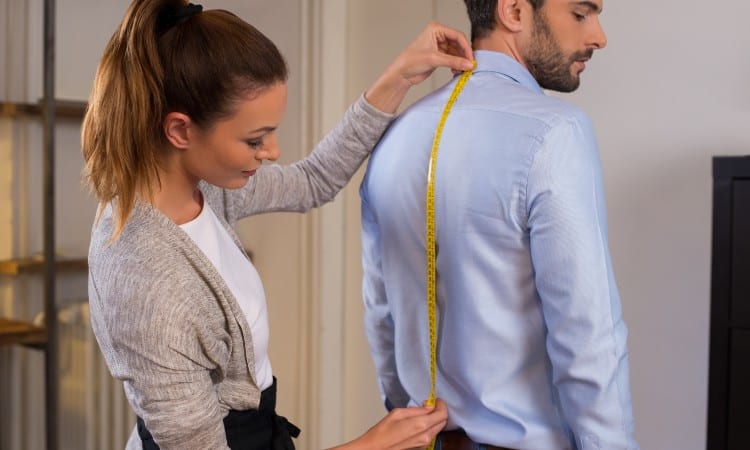Do you struggle to tuck in a dress shirt because the hem always feels too short? The fact of the matter is that everyone has a unique torso length, but most shirt brands only come in a few one-size-fits-all lengths. The good news is that learning how to measure shirt length will help you find a shirt that matches your body shape!
To measure the length of a shirt, measure the distance between the yoke and collar seam to the hem at the center back of the shirt. The most popular way to measure men’s shirt length is to take a full-body measurement. Women’s shirts can come in various lengths, but a torso measurement provides a good length measurement for most tops.
In this article, you will learn how to take five different measurements to find the best shirt length for you. You will discover common shirt measurement tricks. Finally, you will find out how to know if the length of a shirt fits you well or not.

How to Measure Shirt Length
You can measure shirt length by measuring a physical garment or yourself. Once you know the best shirt length for you, all you have to do is look for new tees or button-downs with that measurement and you will never have to worry about a shirt that won’t stay tucked in or a too-long tee that hangs past your hips again!
1. On a Shirt

One easy way to find the best shirt length measurement for you is to measure the length of a shirt that fits you well. You can then note down the measurement and compare it to the length listed in the sizing chart for a new shirt you want to buy
You should try this method on multiple different styles of shirts, as different kinds of tops should have different lengths. For example, you should wear a button-down with a rounded hem tucked in, meaning it needs extra length. But you wear a button-down with a flat, straight hem untucked, and it should have a shorter length.
- Start by ironing or steaming the shirt to make sure it does not have any large wrinkles in it.
- Button the front of the shirt, and then spread it out face down on a flat surface.
- Smooth out the shirt, so the whole expanse of the back lies flat.
- Find the yoke seam near the top back of the shirt, where the collar attaches to the yoke. The yoke looks like a curved piece of fabric that stretches across the backs of your shoulders when you wear the shirt.
- Place the short end of a tape measure at the middle of the yoke and collar seam. Use one hand to hold the tape here.
- With your other hand, smooth the tape in a straight line to the center back of the hem.
- Write down the shirt length measurement.
To find the length of a t-shirt, you use almost the same method. Most tees do not feature a yoke, so start by placing the short end of the tape measure at the point where the shoulder seam meets the crewneck collar. Then stretch the tape in a straight line down to the hem.
2. Length of Shirt for Height
The most popular way to figure out a good t-shirt, henley, or hoodie length for you is to use a height and weight calculator that estimates the size based on your overall proportions.
Shirt size calculators like this one guess your size when you input your height and weight. The calculator uses a simple equation to match your body type to the measurements used by a particular brand and tells you which size should fit you.
You can also use a calculator that offers the reverse of this process, estimating a shirt’s chest and length measurements based on the size you input.
The downside to using a height/weight calculator is that the answer you get only works for one particular brand or style. Gildan t-shirts use different sizing metrics than Hanes tees, for example, which means that guessing the best size and length based on your height is not the most effective method, though it remains popular because it is so easy!
3. Full Length/Torso Length

The best way to find a shirt length measurement for you is to take a torso or “full length” measurement on your own body. This way, you will know exactly what length you want, and you can easily check a sizing chart to make sure any new tops you buy offer that length.
Tailors and high-end brands refer to this measurement as “full length” because it tells you the full length of the shirt, not your whole body. You only want to measure the length of your torso for this method.
- Ask a friend to help you with this measurement.
- Start by deciding where you want the hem of the shirt to end. For example, most button-downs should reach halfway down your fly to provide enough length for tucking in. Mark this point on your pants with a safety pin.
- Place your feet hip distance apart and stand up straight, but keep your shoulders relaxed.
- Have your friend place the short end of the tape at the center back of your neck, right where the collar of a shirt would connect to the yoke.
- Now have your friend drop the tape in a straight line down to the point you marked on your pants.
- Round up to a full-inch measurement and then write down this perfect length measurement!
4. For a Man
The best way to measure shirt length for a man is to use the torso length measurement to reach key points on your body, like this:
- For a button-down with a round hem, the lowest curve of the hem should reach the bottom of your seat or most of the way down the fly of your pants. This provides enough fabric at the bottom of the garment to easily tuck into the waistband of your pants.
- For a button-down with a flat or mostly straight hem, you want the hemline to hit your pants mid-fly. The shirt should cover the top half of your rear end. This length allows you to move around, sit, and stand without showing any skin between your pants’ hem and waistband.
- For a t-shirt, you want the hem to reach two inches below the waistband of your pants. The easiest way to take this measurement is to ask a friend to help while you wear the pants or jeans you plan to wear with the tee. That way, you can use the pants waistband as the lower reference point in your torso measurement.
You should take several different length measurements, one for each style of shirt you like to wear. Then match your measurement to the length listed in a sizing chart before buying a new shirt in that style.
5. For a Woman
The best way to measure shirt length for a woman is to use a back-waist length measurement. This does not tell you the specific length of a shirt. Instead, it ensures that a top will always fit the shape of your torso no matter what length the garment has.
This kind of measurement works well because women’s tops come in different lengths and styles. For example, a crop top, a peplum blouse, and a fitted tee will all reach different points on your body.
To take a back-waist measurement:
- Start by locating your natural waist. Often this is the most narrow portion of your torso, where your body curves inward above your hips. You can also find this point by measuring two inches from your navel. Mark this point on a close-fitting top like a tee or cami by knotting a string around your waist at this level and using a safety pin to hold the string in place.
- Next, place the short end of a tape measure at the center back of your neck, at the level where your neck meets your shoulders. You can use a mirror to find the right spot or ask a friend to help since it is tough to measure your own back!
- Smooth the tape down the center of your back until it reaches the string marking your natural waist.
- Round up to the nearest full inch and write down this measurement.
The catch with this measurement is that not all brands will list a back-waist measurement in a sizing chart. High-end brands and dress shirt manufacturers likely will, as this is the official measurement tailors and clothing designers typically use. But many cheaper, fast fashion brands may not.
In this case, look in the sizing chart for a column that says “shirt length.” Then apply that measurement to yourself by placing the short end of a tape measure at the back of your neck and tracing the tape down your center back till you reach the length measurement listed in the chart. This will show you where the hem of the top will hit on your body.
Shirt Length Questions

Now that you know all the best ways to measure shirt length, check out the answers to common questions about this measurement.
What is the Length of a Medium Shirt?
The average length of a medium-sized shirt for men is about 30 inches, and the average length of a medium women’s shirt is between 27 and 29 inches, depending on the type of women’s top. You see these average lengths most often in t-shirts, as other styles, such as button-downs, have varying longer or shorter lengths based on the cut of the garment.
The length of a specific medium shirt depends on the type of garment and its brand, as no two brands use the same measurements to determine the sizing. Plus, medium-sized women’s, men’s, junior, or children’s shirts will all have different lengths, as well!
How to Measure T-Shirt Length
The best way to measure t-shirt length for men and women is to measure from the shoulder to the hem on a tee.
- Put on a tee that fits you perfectly. Make sure you like the hemline length and that it hits you just about two inches below the waistband of your pants.
- Place the short end of a tape measure at the side of your neck, right where the shoulder of the tee connects to the crewneck collar.
- Hold the tape there. Let the long end of the tape fall down your back in a straight line to the hem.
- Write down the length measurement, rounding up to the nearest full inch.
How to Measure the Length of a Top
The easiest way to measure the length of a top is to measure the distance from the back of the collar to the hem.
Women’s tops come in many different cuts and styles. Some tops may look like mini dresses with a bodice and a full peplum skirt. Others might have a loose, puffy peasant blouse style or a skin-tight stretch knit fit.
- When you measure a top with a ruffled, full, or gathered lower section, the best method is to spread it flat on a hard surface. Make sure you smooth out the hemline before you start. This will open up the full expanse of the hemline and let you find the lowest point if it curves.
- The best way to measure the length of a tight, stretchy top is to put it on before measuring. If you lay it out flat to measure it, the elastic shape of the garment could contract and you will not find out how long the top reaches on your body.
- You can measure poofy, loose tops meant to tuck into your pants like you would measure for a button-down. Simply flip the top face-down and measure from the seam where the yoke meets the collar to the center back of the hemline.
How Do You Measure Shirt Length and Width?
The overall best way to measure shirt length is to take a full-length measurement from the yoke seam to the hem, and the best way to measure the width of a shirt is to find the circumference by measuring from one armpit to the other and doubling that number.
The length of a shirt tells you how long it will reach down your torso. The width tells you how tightly it will fit around the widest part of your chest or bust.
You can also measure yourself to find the best length and width measurements for you. To measure yourself for shirt length, use a full-length measurement for men or a back-waist measurement for women.
To measure the best shirt width for you, stand with your arms at your sides and your shoulders relaxed. Then wrap a tape measure around your chest, starting right beneath your armpit. Make sure the tape stays level and does not sag as it wraps all the way around you.
Some brands list the chest and width as two separate measurements. In this case, the brand lists half of the chest measurement as the width. You can also find this form of width measurement by simply measuring from one side seam to the other right below the armpits of a shirt.
Once you know the length and width that will fit you best, you can simply compare your measurements to those listed in a sizing chart for any tops you want to buy.
Shirt Measurement Template
These shirt measurement templates will give you an idea of the average lengths and widths for men and women. Keep in mind that every brand will have its own size chart. In fact, different styles of shirts sold by the same brand will probably have unique lengths, too!
Because of this, you should always look at the size chart for a specific product before purchasing.
Women’s Shirt Measurement Template: Average Measurements
| Size | Width | Chest | Length |
| XS | 16.5” | 33” | 27” |
| S | 18” | 36” | 28” |
| M | 20” | 40” | 29” |
| L | 22” | 44” | 30” |
Men’s Shirt Measurement Template: Average Measurements
| Size | Width | Chest | Length |
| S | 18.5” | 37” | 28” |
| M | 20.5” | 41” | 29.5” |
| L | 22.5” | 43” | 32” |
| XL | 24” | 48” | 32.5” |
How Should Shirt Length Fit?

Determining how shirt length should fit depends on your body type and the style of shirts you like to wear. Check out this style guide to find simple tips to match the best length to your body!
First, these general rules work for both men and women:
- Most t-shirt styles look best when the hem ends two inches below the waistband of your pants. You can test this length by raising your arms fully over your head. If the tee lifts but does not reveal your midsection, it has a good length for you!
- For tuck-in shirts such as button-downs or poofy blouses, the shirt should hang low enough to cover your rear end when it is not tucked in.
- For dressier shirts, you do not want to tuck in, like polos or button-downs with flat hems, look for a perfect length with a hem ending halfway down the fly of your pants. This type of shirt should not fully cover your seat. Instead, it should ideally reach about halfway down the seat of your pants.
Another way to find the best shirt length for you is to consider your body type.
For men:
- If you have a rectangular body type with equally wide shoulders and waist, try a slim-fit tee or tailored button-down to make your waist appear more narrow. These types of tops often have a slightly shorter length and can look better left untucked in many cases.
- If you have a triangular or oval body shape, go for a classic or regular cut in your t-shirts and button-downs. These roomier styles will not pinch in at your wider waist or hips and often come with longer lengths to accommodate a rounder torso.
- If you have an inverted triangle body type with muscular shoulders, you can highlight your build by choosing athletic-cut tees and button-downs that allow roomier sleeve openings and shoulders but taper in at the waist. T-shirts in this style often have a physically longer length to accommodate the curve of your chest, though they will still end about two inches below your waistband.
For women:
- If you have a pear-shaped or triangular body type, try wearing fitted women’s cut tees or tailored tops that nip at the waist. Avoid poofy blouses with a longer length, as this will disguise your waist.
- If you have a slender rectangular body shape, look for tops with a classic or regular cut. You can safely wear longer, looser button-downs or blouses that tuck into pants or skirts.
- For plus-size women, one of the best types of tops you can wear is a peplum that has a flared lower half of the top, hiding your rounded waistline. These blouses often end either right below the waistband of your pants or halfway down your hips.
Conclusion
One of the simplest ways to measure shirt length is to spread out a shirt on a flat surface and measure the distance between the yoke and collar seam and hemline. The best way to measure shirt length on your body for men is to use the full length or full torso measurement spanning between the center back of the neck to the point you want the shirt to end on your body. For women, use a back-waist measurement that ends at the natural waist.
You may find it helpful to take several measurements because shirts often feature different lengths based on the style of the shirt. For men, t-shirts and button shirts with a flat hem often have a shorter length than dress shirts with a curved hem, meant to tuck in. Women’s tops come in many different styles, like blouses, t-shirts, and button-downs, and every style often has a preferred length.
Have you ever checked the shirt length in a sizing chart before purchasing? Did you end up with a shirt that fits you well? Leave a comment below to let us know!